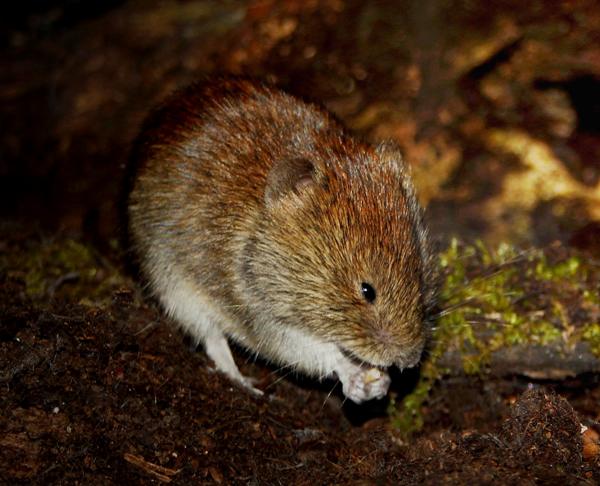Myodes glareolus - Bank Vole
Phylum: Chordata - Class: Mammalia - Order: Rodentia - Family: Cricetidae

Bank Voles, the smallest vole species native to Britain, are busy little rodents that do not hibernate. All through the year they forage for food along tunnels pushed through grasses and other dense vegetation, and they are good swimmers perfectly able to cross flooded ditches and streams when necessary. Maybe they pay a price for this active lifestyle, because Bank Voles do not normally live for more than two years.
Identification
Bank Voles have smallish rounded ears and roundish faces. With a typical body length of 10cm and a tail adding a further 6cm, the Bank Vole is readily distinguished from the Field Vole by the richer reddish-brown coat on its back. The underside is a dirty grey colour.
Distribution
Bank Voles are found throughout Britain. They are not native to Ireland but are present in the south west where they were accidentally introduced in the 1950s. On Skomer Island, off the coast of Pembrokeshire in west Wales, a very large form (about twice the size of the Bank Voles on mainland Britain, and known as the Skomer Vole) has been present for many hundreds of years.
Apart from the far north and extreme south, Bank Voles are recorded throughout mainland Western Europe; they also occur in some parts of Asia.
Feeding
Nuts, seeds and berries are their staple diet, but Bank Voles will also nibble at roots and wildflower bulbs. They can sometimes be seen climbing up Hazel trees when the nuts are ripening in late summer and early autumn, and they gather more than they can eat, storing up reserves of food in small holes which they dig in banks.
Predation
Owls and other birds of prey as well as mammals prey on Bank Voles, and their only escape tactic is to remain concealed for as much of the time as possible in the tunnels that they create on or just under the surface in dense grassland and other tangled vegetation, often on the edges of woodland or beside hedges.
Breeding
In spring and summer, Bank Voles nest in small holes lined with grass, fur, feathers and moss beneath trees, bushes or hedgerows. They produce typically three to five litters in a year with up to eight young in a litter. Within three months the young are not only self sufficient but also able to breed! Inevitably, predation increases when the young and inexperienced set out in search of food; were that not so we would surely see a lot more Bank Voles (and far fewer Hazel nuts!).
Acknowledgements
This page includes pictures kindly contributed by Will Bown.